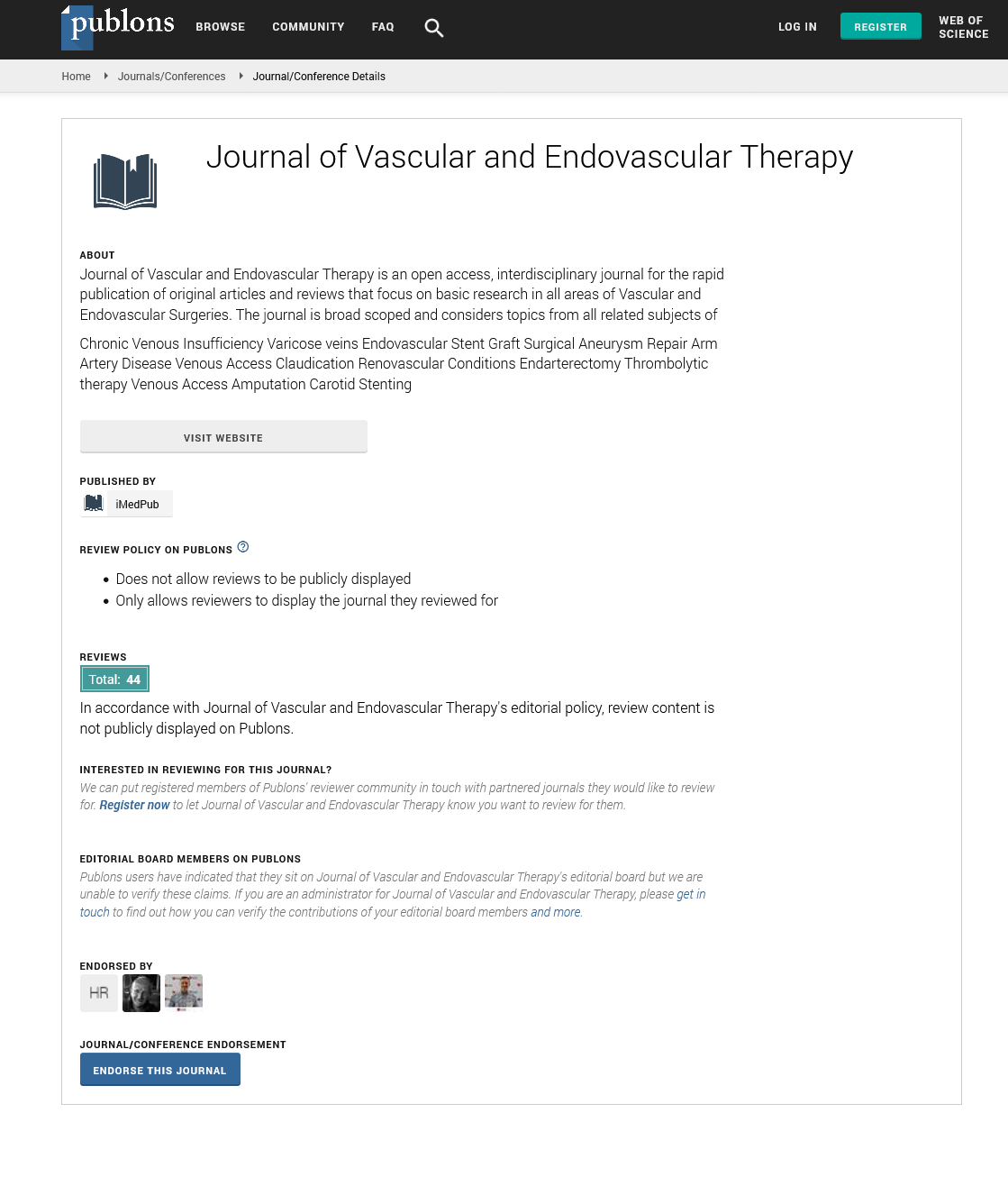ISSN : 2634-7156
Journal of Vascular and Endovascular Therapy
Is coil embolization effectively and minimally invasive in the young man suffering from veno-occlusive dysfunction?
3rd Edition of World Congress & Exhibition on Vascular Surgery
May 24-25, 2018 London, UK
Chi Can Huynh and Geng Long Hsu
The Male Clinic, Australia Hsu′s Andrology, Taiwan National Taiwan University, Taiwan
ScientificTracks Abstracts: J Vasc Endovasc Therapy
DOI: 10.21767/2573-4482-C1-002
Abstract
Is coil embolization effective and safe to treat impotence resulting from veno-occlusive dysfunction, we report five cases and literature review. From 2012 to 2017, refractory impotence prompted five young men to consult us despite coil venous embolization performed elsewhere. All patients were evaluated with general x-ray, Doppler sonography, computerized tomography, the abridged 5-item version of the international index of erectile function (IIEF-5) and our dual pharmaco-cavernosography. They were treated with the latest method of penile venous stripping which was carried out with circumferential and pubic longitudinal approaches under acupuncture aided local anesthesia. The deep dorsal vein, cavernosal veins were thoroughly stripped while the para-arterial veins were ligated segmentally. Followup cavernosography was routinely conducted for confirming sufficient venous stripping and comparison of radio-opacity between the femoral cortex and the corpora cavernosa especially the penile crura while the IIEF-5 follow was merely made via the internet. A review of the literature on coil embolization was obtained using Medline. Coils migration took place in four patients in which each two were found in pelvic and pulmonary area respectively and one patient disclosed dozens of coils in the periprostatic plexus, all had no improvement in impotence. Postoperative cavernosography discloses the radio-opacity of the penile crura was denser than that of the femoral cortex. However, the IIEF-5 score changed from 10.4±2.4 to 15.9±2.8, p 0.001. One man required additional oral sildenafil and two men ended with a penile implant. Coil migration was not uncommon in the medical literature, which varied from 2.5% to 11.1%. The efficacy of penile venous embolization appears controversial, and its safety may not be sustainable although larger samples may be required.Recent Publications 1. Hsu G L, Chen H S, Hsieh C H, Lee W Y, Chen K L and Chang C H (2010) Clinical experience of a refined penile venous stripping surgery procedure for patients with erectile dysfunction: is it a viable option? Journal of Andrology 31:271-280.
2. Hsu G L, Chen H S, Hsieh C H, Lee W Y, Chen K L and Chang C H (2010) Salvaging penile venous stripping surgery. Journal of Andrology 31:250-260.
3. Hsieh C H, Liu S P, Hsu G L, Chen H S, Molodysky E, Chen Y H and Yu H J (2012) Advances in our understanding of mammalian penile evolution, human penile anatomy and human erection physiology: clinical implications for physicians and surgeons. Medical Science Monitor 18:RA118-125.
4. Hsu G L, Hung Y P, Tsai M H, Hsieh C H, Chen H S, Molodysky E, Huynh C C and Yu H J (2012) Penile veins are the principal component in erectile rigidity: a study of penile venous stripping on defrosted human cadavers. Journal of Andrology 33:1176-1185.
Biography
Chi Can Huynh graduated from Sydney University in 1999. During his senior years in Medical School he completed a Surgical Research Term with Tom DeMeester at the University of Southern California. He was accepted into
the Advanced General Surgical training scheme in 2003 and then onto the Advanced Urology Training Program in 2005. He was the inaugural Robotic Fellow at St. Vincent’s Prostate Cancer Centre in 2008. Following this, he spent 18 months in Manchester (United Kingdom) completing a laparoscopic prostate fellowship. He has interests in erectile restorative surgery and robotic prostate surgery and was the first in Australia to perform a robotic assisted radical nephro-ureterectomy and penile erection restorative vein surgery. His research interests are in erectile dysfunction and he is a part time fellow in erectile restorative surgery overseas. He co-authored papers in peer reviewed medical journals and presented multiple international conferences on the topic. He also holds teaching positions with the Rural Medical School of the Australian National University and the Australian School of Advanced Medicine.
Email:urocch@gmail.com
Email:genglonghsu@gmail.com
Google Scholar citation report
Citations : 177
Journal of Vascular and Endovascular Therapy received 177 citations as per Google Scholar report
Journal of Vascular and Endovascular Therapy peer review process verified at publons
Abstracted/Indexed in
- Google Scholar
- Open J Gate
- Publons
- Geneva Foundation for Medical Education and Research
- Secret Search Engine Labs
Open Access Journals
- Aquaculture & Veterinary Science
- Chemistry & Chemical Sciences
- Clinical Sciences
- Engineering
- General Science
- Genetics & Molecular Biology
- Health Care & Nursing
- Immunology & Microbiology
- Materials Science
- Mathematics & Physics
- Medical Sciences
- Neurology & Psychiatry
- Oncology & Cancer Science
- Pharmaceutical Sciences
